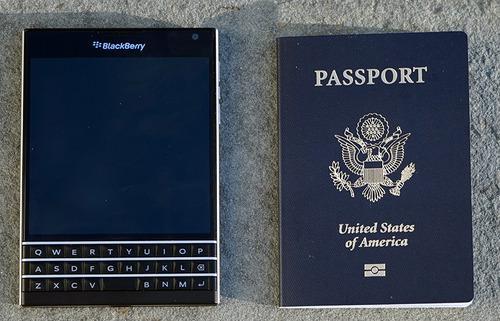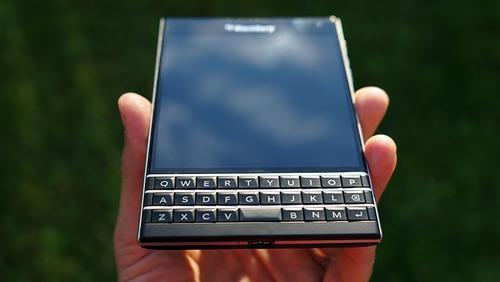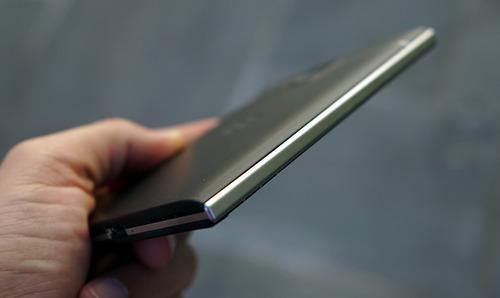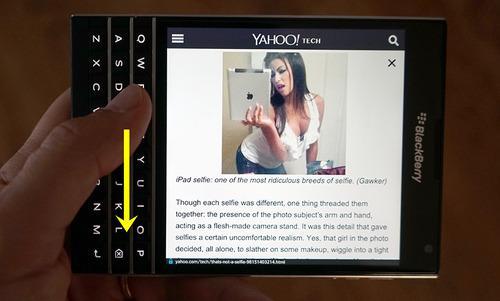 The Passport is big and thick and heavy, with a square screen.
The Passport is big and thick and heavy, with a square screen.
By:David Pogue
The touchscreen smartphone has become one of the most successful product categories of all time. But its popularity has blasted holes in a lot of other industries. So many other product categories are sinking or sunk: pocket cameras, GPS units, music players, voice recorders, radios.
And, oh yeah — the BlackBerry.
Poor, poor BlackBerry. At its peak, about 60 million people a year bought BlackBerry devices (or had them bought for them).
But when the iPhone came out, BlackBerry’s leaders didn’t just miss the boat. They were at the completely wrong port. They were late to add a camera, late to create an app store. Quality slipped. Marketing was nonexistent. The stock tanked (from $150 to about $10 a share). Market share tanked (from 20 percent to under 1 percent). And with the phones sinking, the BlackBerry tablet capsized, too.
Thousands were laid off. The CEO was replaced. The replacement CEO was replaced.
Today, BlackBerry says that it has stabilized, smaller but wiser. It’s going to focus on business customers, exploiting BlackBerry’s famed efficiency and security. As proof, today it offers the first new BlackBerry phone since the new CEO took the helm: the BlackBerry Passport. (It’s $600 without a contract or $250 with a two-year AT&T contract.)
This is one weird-looking phone.
It is, in fact, the size of a U.S. passport. I mean, plenty of people will suppress giggles when they first see it — or fail to suppress them.

Once you get over the awkward size and shape and heft, you start to learn about this thing’s virtues, though, and you feel a little guilty for laughing.
First, there’s the classic, beloved, fantastic BlackBerry thumb keyboard. Real keys that actually move. Bigger and more spaced out than on the much narrower BlackBerry phones of old. It’s wonderful.

Second, what makes this phone thick is the battery. It occurred to somebody over at BlackBerry that what people don’t like about current smartphones is running out of battery every dang day. So this one goes two, even three days on a charge. That’s fantastic.

Third, the keyboard itself is a trackpad. Nobody’s done that before. In other words, you can drag your finger lightly across the physical keys to make things move on the screen.
For example, it’s how you move the cursor through text — by swiping across the keys.
It’s also how you flick words from the BlackBerry’s word-suggestion feature (recently stolen by Apple’s iOS 8) into the text — by swiping, on the keys, upward beneath the word you want.

You can swipe leftward across the keys to delete a word at a time. Or swipe down on the keys to summon the number/punctuation layout.
Finally, you can turn the whole phone 90 degrees (the screen is square, remember?) and use the keys as a very precise scrollbar for webpages.

All of this, plus the big square screen (1440 pixels square), is supposed to address a common quirk of business people: They often wait to do things until they’re back at a computer. A typical phone is just too claustrophobic for anything more than quick replies.
That logic is a little warped, of course, because lots of phones have huge screens these days. The iPhone 6 Plus and Samsung Galaxy S5 are taller, narrower phones, but their screens have the same number of pixels.

But BlackBerry maintains that reconfiguring them into a square offers a broader canvas when you’re looking at, for example, calendars, ebooks, and maps.

It’s worth pointing out, though, that the square screen is terrible for watching movies. You’ve got a movie best suited for ants, playing on a huge black empty screen:

Everything else you’d expect is here: front and back cameras, flash, Bluetooth, NFC, removable memory card, quick access to settings, and so on. The sound quality is terrific, both on calls and when playing music or movies. The battery is not removable, however.
There’s an app store — there are two, actually. One contains BlackBerry apps (several thousand), and the other is the Amazon Android app store (200,000 apps). Yes, the BlackBerry OS has a built-in Android emulator that lets you run anything from the Amazon Android app store. (You can even try running any non-Amazon Android app on this thing, but they’re not guaranteed to run smoothly.)
Entering text
I’m guessing that diminishing numbers of young phone fans have ever even tried typing on a physical, clicky phone keyboard; it’s just taken for granted that text input means tapping on glass. Well, I’ll tell you: Physical keys are a joy.
The BlackBerry Passport offers a number of text-entry tricks — some old, some new — that make it even better. For example:
• Whenever you’re typing, a fourth row of keys appears on the screen, just above the physical ones. It offers punctuation keys, sometimes number keys — whatever is most useful at the moment. The point is that, on this phone, you never have to switch keyboard layouts just to get a comma or an exclamation point.
• Hold down one of the physical keys an extra half-second to capitalize it — and to open a row of accented variations (like é or î).
• You can dictate text. The recognition is fine, although it’s nowhere near as good as it is in iOS 8. It doesn’t display the words as you speak them, either, as Android and iOS 8 do; instead, you see nothing while you dictate, and then the words appear all at once.
BlackBerry 10.3
The Passport is the first phone to come with the new 10.3 version of the BlackBerry software. It offers many large and small enhancements, but the company seems especially proud of BlackBerry Assistant — which everyone else will recognize as “Siri for BlackBerry.”
This phone has no Home button. To get back to your Home screens, you swipe the current app up off the screen. So to tell “Siri” to start listening, you hold down the Play/Pause button on the right side of the phone.
It’s an impressive facsimile. You can say, “Make an appointment for lunch, tomorrow at 1 p.m.,” “Email Cheryl,” “Set my alarm for 7:30 a.m.,” “Play some Billy Joel,” “Text Chris,” “Give me directions to the Empire State Building,” “When is the next Cleveland Cavaliers game?” “Turn off Bluetooth,” and so on. Each time, BlackBerry Siri does exactly what you’d expect.
Her voice is less natural than Siri’s. And she takes a long time to process things you say. Even so, the lesson of Siri is now the lesson of BlackBerry: It’s almost always faster to open an app, set an alarm, place a call, or start an email by voice — rather than tapping around for the app you need.
Shortcuts
You can type BlackBerry Assistant commands, too, which is great whenever it might be awkward to speak commands aloud (library, church, surgery).
That’s only one example of the kinds of efficient shortcuts that the BlackBerry has always been so good at. Me, I love these things. For example, when you’re looking at any kind of list (like your inbox), you can press the T or B keys to jump to the top or bottom of the list. N or P moves you to the next or previous section of something. In email, press C to compose, R to reply, F to forward, and so on.
There are 200 of these shortcuts in BlackBerry 10.3. You’re not expected to learn them all, but over time, you become truly amazed at how thoughtfully they’ve been designed.
BYOD
“BYOD” means “Bring your own device,” and it’s a thorn in BlackBerry’s side. It refers to employees bringing their own personal phones (usually iPhones and Android phones) in to work.
Corporate network geeks are a paranoid bunch. As you know if you’ve ever worked for a big company, they hate people mixing personal stuff with company stuff; in fact, they often don’t allow it. They insist on your using a separate phone and laptop for work purposes.
BlackBerry has, for a couple of years, offered a clever “sandboxing” solution called BlackBerry Balance. In effect, it creates two worlds on the same phone, called Work and Personal. Your work calendar, contacts, and apps are kept separate from your personal ones.
To switch modes, you swipe down from the top of the screen and tap either Personal or Work. (In Work mode, your bosses can install their own wallpaper, provide their own apps, and even disable your camera.)

Without your work password, you can’t see any of your company material. Your calendar shows appointment blocks but doesn’t identify them.
And if you leave the company, your bosses can delete the whole Work world or Personal world in one swift click.
With the BlackBerry Passport, however, there’s another development: something called BlackBerry Blend. It lets you connect your phone to any computer or tablet — your own personal laptop, for example, or an Android tablet or iPad — by WiFi or a USB cable.
At that point, using the Blend app on your computer or tablet, you can work with everything on your BlackBerry: email, text messages, BBM (BlackBerry’s popular private messaging system), calendar, files. It’s a live, encrypted link.

You can use your full-size keyboard and trackpad to work with all the company stuff that’s on your phone. And you can access your company’s email and networks without having to fuss with a VPN (virtual private networking) setup.
The best part is that nothing ever actually moves to your laptop. Your phone stays corporate-secure, and your overlords are satisfied. When you disconnect, no trace of your phone’s contents remain on the computer or tablet.
Unfortunately, BlackBerry Blend wasn’t ready in time for me to test. I saw a demo but couldn’t try it myself. If it works, it sounds very cool.
Passport to anywhere?
The BlackBerry Passport is unusual, innovative, and weird. It has pros and cons that don’t line up with any other phone. It feels a little slow sometimes, and of course it’s like typing on a Pop-Tart; this is not a one-handable phone.
If BlackBerry can get its act together and finish assembling all the pieces … if it can get corporate worker bees to try it … if it can somehow get onlookers not to point and laugh … then the Passport might have a future, although a limited one with a select audience.
But public opinion is a big battleship to turn around. And unfortunately for BlackBerry, the tide is against it.
No comments:
Post a Comment